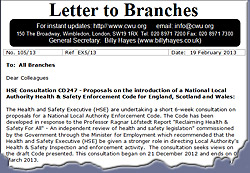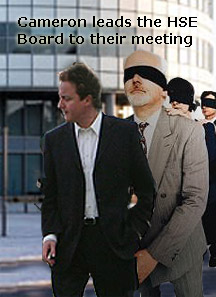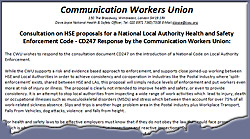 |
 |
|
The Health and Safety Executive (HSE) are undertaking a short 6-week consultation on proposals for a National Local Authority Enforcement Code, reports Dave Joyce, CWU National Health, Safety & Environment Officer:
This consultation is just one of many more so called simplification and revocation Consultations that have happened or are going to follow.” Writing in his letter to all CWU branches (LTB105/13), Dave goes into detail about the proposed code and the reasons for it: “The Code has been developed in response to the Professor Ragnar Löfstedt Report "Reclaiming Health & Safety For All" - An independent review of health and safety legislation" commissioned by the Government through the Minister for Employment which recommended that the Health and Safety Executive (HSE) be given a stronger role in directing Local Authority's Health & Safety Inspection and enforcement activity. The consultation seeks views on the draft Code presented. This consultation began on 21 December 2012 and ends on 01 March 2013. In the Consultation Document (CD) the HSE has published a draft list prescribing 10 ‘high risk’ sectors, ahead of proposed Code banning local authorities from proactive Safety Inspections of so called ‘low risk’ premises. The proposals have sparked fears that a number of potentially hazardous activities could be left unchecked.
Dave discusses the issues around the question of categorising workplaces based on ‘risk’: “The proposed 'High-Risk' list for proactive Inspections is vague but includes premises with: * cooling towers and evaporative condensers for legionella control measures, * LPG Pipework such as Caravan Parks for explosion risks, The full LTB contains further details of the working environments listed in the document. “Under these proposals however cooling towers would be subject to proactive inspections at least every five years. Premises such as the Stoke on Trent warehouse at the centre of a legionnaires disease outbreak last year would not be inspected, as the disease was traced to a spa bath display. Dave urges all USRs to respond to this consultation document because of the ramifications involved. The LTB states that: “The CWU Health, Safety and Environment Department has responded to the consultation document on the introduction of a National Code on Local Authority Enforcement stating that while the CWU supports a risk and evidence based approach to enforcement, and supports close joined-up working between HSE and Local Authorities in order to achieve consistency and co-operation in Industries like the Postal Industry where 'split-enforcement' exists, shared between HSE and LAs, this proposal will simply reduce levels of enforcement and put workers even more at risk of injury or illness. The proposal is clearly not intended to improve health and safety, or even to provide consistency. It is an attempt to stop local authorities from inspecting a wide range of work activities which lead to injury, death or occupational illnesses such as musculoskeletal disorders and stress which between then account for over 75% of all work-related sickness absence.
Dave explains what ahs led to this consultation document and comments on the government’s attacks on health and safety protection at work legislation: “In March 2011 the Government issued instructions to the Health and Safety Executive to stop all proactive inspections in a wide range of industries including Postal services, transport (including docks), education, electricity, light engineering, textiles, health and social care. The reason that they gave, in most cases, was that the premises are “low risk”. In fact many of the sectors identified have much higher levels of injury and ill-health caused by work than those that are still to be inspected. The government also told Local Authorities to stop most of their pro-active inspections. It is already estimated that, prior to the introduction of the National Code, for 2012/13 Local Authorities will have reduced their pro-active inspections to 16,400. This is a reduction of 86% in just three years. These have been both in premises that the government considers “low risk” and those where they have been designated “high risk” or “Category A” where the number of proactive inspections has fallen by 43%.” The CWU remain strongly opposed to many of the changes proposed by Lord Young report "Common Sense, Common Safety" and Professor Ragnar Löfstedt's Report "Reclaiming Health & Safety For All" which the HSE were under firm instruction from the DWP Minister and Government to implement. All Safety Reps are encouraged to respond to this consultation exercise. Responses should be sent to: HSE Local Authority Unit CWU Health, Safety & Environment Department's response on behalf of CWU HQ can be downloaded by clicking the pic above or via the E-Library Database Download LTB105/13 in full here Source: CWU / HSE |

 The communications industry has been categorised as "Low Risk" despite high numbers of accidents and fatalities which occur every year within the industry. The CD states that Councils should use the ‘full range of regulatory interventions available’ to target only 'higher risk businesses' and the proposed Code rules out proactive Safety Inspections unless premises are listed as high-risk.”
The communications industry has been categorised as "Low Risk" despite high numbers of accidents and fatalities which occur every year within the industry. The CD states that Councils should use the ‘full range of regulatory interventions available’ to target only 'higher risk businesses' and the proposed Code rules out proactive Safety Inspections unless premises are listed as high-risk.”
 For health and safety laws to be effective employers must know that if they do not obey the law they could face prosecution which is why the CWU has supported a mix of proactive inspections and reactive inspections. Overall proactive inspections should be targeted at those areas where they would be most effective, but no workplace should be excluded from the possibility of an unannounced inspection especially the Postal and Telecommunications Industry.”
For health and safety laws to be effective employers must know that if they do not obey the law they could face prosecution which is why the CWU has supported a mix of proactive inspections and reactive inspections. Overall proactive inspections should be targeted at those areas where they would be most effective, but no workplace should be excluded from the possibility of an unannounced inspection especially the Postal and Telecommunications Industry.”